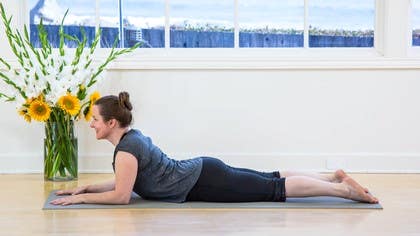Description
See attached .PDF that goes along with this class.
About This Video
Transcript
Read Full Transcript
I had diastasis recti after my three pregnancies, and I didn't even know. I was experiencing some low back pain, pelvic pain, but other than that, I thought those were just normal symptoms for a mom, picking up toddlers, not getting a lot of sleep, and having had two cesareans, but it wasn't until I visited a pelvic floor physiotherapist that she told me that I had diastasis, and it was really easy to figure out that some of the movements I was doing in yoga and some of the breathing that I was doing or not breathing were contributing to it. So I want to show you some self-assessment, just so you can check in with the tissue at the linea alba, but it is by no means a diagnosis via video here. It's really crucial that if you think you have diastasis that you go and see your pelvic floor physiotherapist. What diastasis is, is that the tissue at the linea alba there, the tissue between the rectus abdominis muscles, it stretches out naturally, and one place where it stretches out naturally is during pregnancy.
So one out of three women have diastasis recti, or diastasis of the rectus abdominis muscles, and some new research is showing us that it's not just about the separation, it's not at all about the separation, it's how that tissue is carrying the load. So it can be a little bit confusing, we're going to get down on the floor and feel around for how that tissue is doing, and just know that there are experts out there as well that can help you. So we'll come down to the floor, come down to lying on your back and bend the knees, plant the feet, find a comfortable place there, and the first part of the assessment will bring fingertips to the belly button, and we're kind of checking the space between the rectus abdominis muscles, but again, it's more so how that tissue does. So we just figure out where is the linea alba, it runs all the way from the pubic bone up towards the rib cage in line with your belly button. So as we move the fingers above the belly button, we're going to just gently lift the head just a little bit off the floor and see if we can feel, is there a space between the rectus abdominis muscles?
How does the linea alba tissue feel? Does it feel like it's firing or does it feel like it's thin there? And it might be different above the belly button than it is below. So when I had my separation, it was just below when I had my diastasis diagnosis, it was just below the belly button, some people are above, and it was about two to three fingers width at that space. So we check it there, and I think the really key thing is that it didn't take a lot.
There was one movement that my physiotherapist got me to do, it was really simple and there were some movements that I took out of my yoga practice that I just wasn't able to breathe through. So that's the first assessment that we do there. Just to see how is that tissue doing between the rectus abdominis muscles? And the next one that we'll do is the cough assessment. So we'll bring one hand to the abdomen and we'll make a little cough and we'll notice what happens with the abdomen.
Does the abdomen move out or does it move in? And we can try that again and see what happens. So a cough is an exhale, and an exhale means that pelvic floor is lifting up and there should be a little hug in. If we notice a big expanse out, it might be that this tissue here isn't carrying the load, isn't holding that as optimally as it could. So that's one assessment there.
And see what it's like to cough and to bring that in. And this is really important when we're looking at incontinence and this load that happens when we cough, we sneeze, we laugh, we want that core to be working in synergy with that. And the last one that we'll do here, we're just going to look at the linea alba again, feel the linea alba, as we come up, is there any tenting? So as we come up this way, is there any tenting that happens there, doming, it's sometimes called where you would actually see a little tent of skin come up. So we test that and see, does that happen?
Or is the reverse happening, which is called invagination, do we feel that it goes inward? So those are kind of three assessments there, and we'll roll to one side, come up to sitting and a really important part of this is that we have continuous breath. So if we have continuous breath during the movement, then we will be looking after that tissue at the linea alba. That's one way to put it. And this is super important for those of you who are pregnant, birthing babes, if you have friends who are birthing babies, is no breath holding ever when we're birthing.
And this can be something that is just a habit that we do or sometimes is cued by people helping us to hold and push, but if we can really look at that, we can look after the tissue at the linea alba as well as pelvic floor. So if we thought about the inner unit, this canister here, like a tube of toothpaste, when we squeeze a tube of toothpaste, the pressure needs to go somewhere. And for me, it was my linea alba, that was the tissue, that's where it was going to give. For some, it can be pelvic floor, that's where we might experience pelvic organ prolapse. So we want to see what movements are increasing the intra-abdominal pressure in a way that we can't carry and sustain it.
So I don't want to make you afraid of movement, I want to empower you with the tools to assess, is this movement okay, or do I need to build up to this movement? So plank is a great example, I didn't do plank for a long time, because I was afraid of it. But instead, when I started building up from plank at the knees, then I was able to do plank and build up. So if we're plank at the knees, and we have continuous breath, and if we could see if there's doming or invagination at the linea alba, if that's not happening, then we've got it. So continuous breath, and not that tenting, doming at the linea alba, those are the key pieces that we're looking for there.
Another one is, and especially in pregnancy, because I was practicing yoga in my pregnancies, and imagine I was holding baby and big babies, and doing things like wheel pose, or full camel pose. But my tissue at the linea alba was already stretched to its max. So instead, what if we look at camel that's like this, where we place the hands down onto something, we open the heart, we still have that amazing heart opening pose, but less pressure onto the linea alba. So that's one way that I modified my camel pose. And then sit ups, and crunches, and curl ups, the amazing news is that I got to take those out completely.
And I learned how to strengthen the core four using many different poses. So those are in different videos in this whole season, which is really exciting. And then the last piece of this is if you've recently had a baby, or if you have a friend who's had a baby, to really look at allowing that healing time in postpartum. So to give the body some time to come back. So those are my things that get me really excited about the tissue at the linea alba.
And I hope you've enjoyed. I'd love to hear from you. Take care.
Yoga for Women's Health: Yoga For Pelvic Health
Comments
Thank you for this informative video!
I have a question about the invagination of the linea alba, without haven given birth, I feel the tissue of the LA doming inwards a little during the exploration in your video.
To what extend can this be called 'normal' and when would it be diastasis recti? I also understand we can have DR without giving birth, correct?
Many thanks!
Yes, it is possible to have DR without giving birth, but it is less common for sure.
It is normal to feel the difference of the tissue -- where the rectus abdominis muscles meet the linea alba and for sure many people feel a slight descent or doming inward there.
The only way to be 100% certain if you have DR is to see a pelvic floor physio. I feel like this is such an informative visit for anyone with a body. Then you can have an expert palpate your linea alba with no movement and with movement.
Let me know if this helps or if you have further questions.
1. Are you able to breathe continuously during this movement?
2. Do you like this movement?
3. Is there any doming or reverse doming at the linea alba and
4. is there pressure felt on the pelvic floor
The other postures in the videos that I share in here are great ones to help to strengthen your core 4, which will help.
If you can breathe continuously, like the movement and if you can manage the pressures to the linea alba and linea alba -- then I would say go for it!
You need to be a subscriber to post a comment.
Please Log In or Create an Account to start your free trial.









